
8 Amazing National Park Structures
Be Amazed
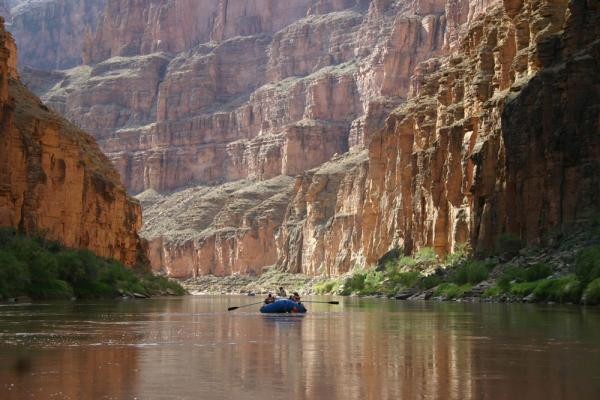
Millions of visitors flock to our nation's amazing national parks each year. More than just weekend getaways, these parks are home to mind boggling geologic formations that show the Earth's hard work through the ages.
From geysers to the Grand Canyon (pictured above), here are eight favorites. After touring them, go out and see them in person. All parks are open free of charge this week during National Parks Week.
Sandstone Arches - Arches National Park, Utah
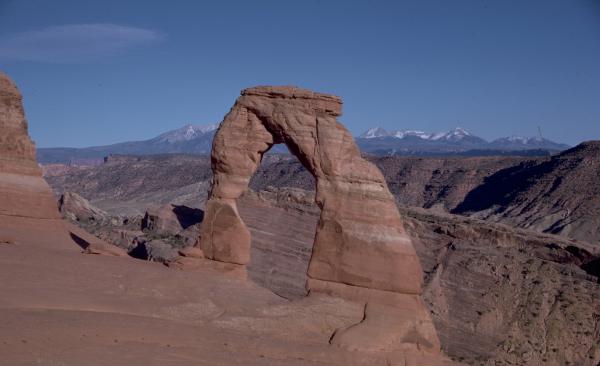
The forces of nature have acted in concert to create the landscape of Arches, which contains the greatest density of natural stone arches in the world.
Throughout the park, rock layers reveal millions of years of deposits, erosion and other geologic events. These layers continue to shape life in Arches today, as their erosion influences elemental features like soil chemistry and where water flows when it rains.
Arches National Park is located in a "high desert," with high elevations, very hot summers, cold winters and very little rainfall. Even on a daily basis, temperatures may fluctuate as much as 50 degrees Fahrenheit (28 degrees Celsius). The plants and animals in Arches have many adaptations that enable them to survive these conditions.
Moonbow at Yosemite Falls - Yosemite National Park, California
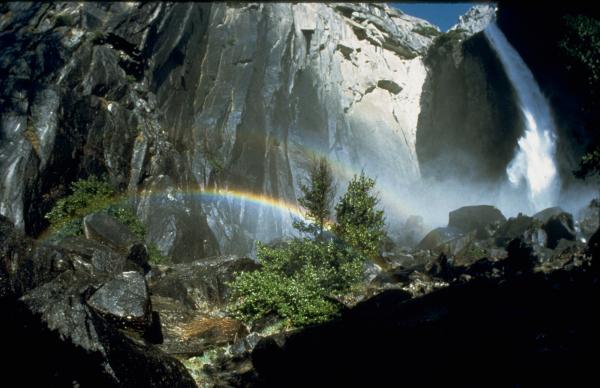
Yosemite National Park, one of the first wilderness parks in the United States, is best known for its waterfalls. One waterfall stands out above the rest, not necessarily because of the waterfall itself, but due to a phenomenon called a moonbow.
A moonbow is basically a rainbow that appears as the moon sets, but it only happens a few times each year as light is reflected off the surface of the moon rather than from direct sunlight.
Lucky park goers can witness this dazzling color display at Yosemite Falls. To see a moonbow at Yosemite Falls you need clear skies, enough water in the falls to create sufficient mist, dark skies, and bright moonlight not blocked by the surrounding mountains.
Old Faithful Geyser - Yellowstone National Park, Wyoming
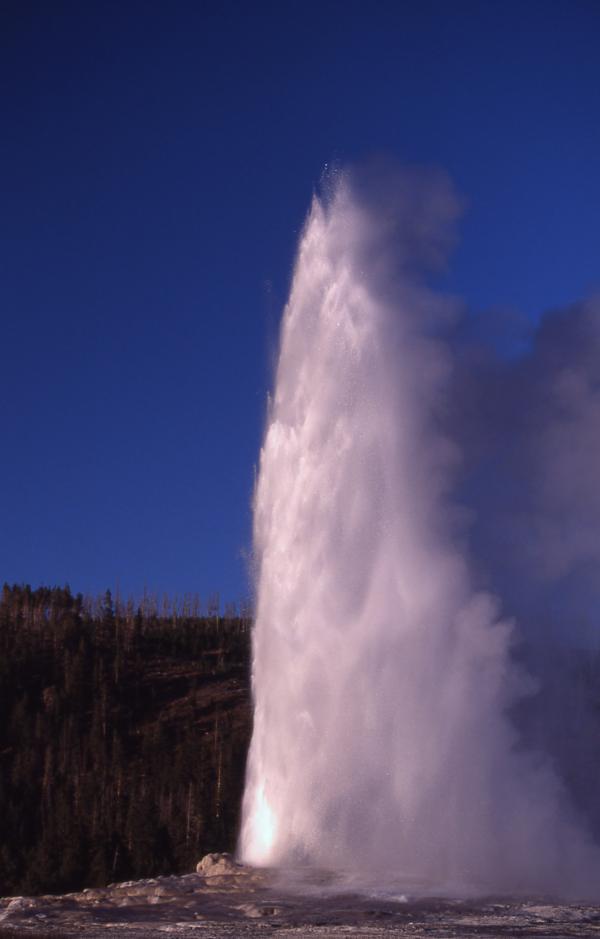
Yellowstone is America's and the world's first national park and home to wildlife such as grizzly bears, wolves, bison and elk. But the park's big draw is its famous collection of water-spewing geysers that make up nearly 60 percent of the world's geysers.
The famous Old Faithful is a cone geyser in Wyoming that can shoot up to 8,400 gallons (32,000 liters) of piping hot water up to 185 feet (56 meters) into the air. The waterworks can last up to 5 minutes long. Eruptions are currently about 90 minutes apart.
Geysers are temporary geological features, lasting only a few thousand years. Intense volcanic heat, underground water and natural geologic plumbing fractures, fissures and other open spaces in rock through which the heated water can escape are required to create a geyser. As the water boils underground, a column of water and steam is blasted out of the geyser's opening. [Infographic: The Geology of Yellowstone]
Yellowstone has more to offer than just geysers of course; the park covers more than 3,472 square miles (8,987 sq km) filled with lakes, canyons, rivers and mountain ranges.
Grand Canyon - Grand Canyon National Park, Arizona
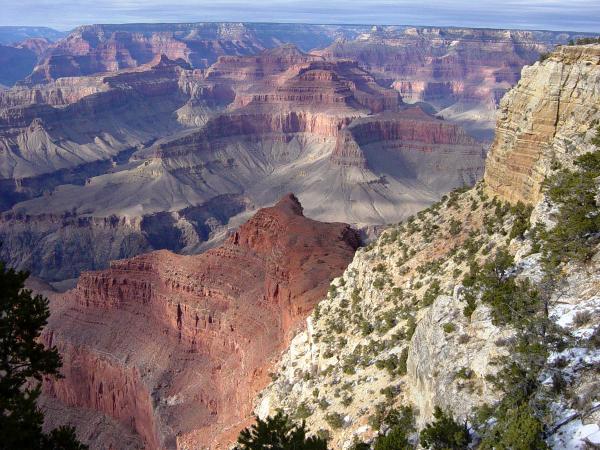
Each year, more than 4 million visitors flock to Grand Canyon National Park, which encompasses nearly 2,000 square miles (5,000 sq km) on the Colorado Plateau in northwestern Arizona.
The Grand Canyon is one of the most studied geologic landscapes in the world. The canyon is a geologic record of three of the four eras of geologic time, contains a rich fossil record, diverse geologic features and numerous caves. The exact age of the Grand Canyon or how long ago it was carved out by flowing rivers is hotly debated. [Grand Canyon: Take a Hike Through Geologic Time]
The Grand Canyon was carved by the Colorado River and averages a depth of 4,000 feet (1,200 meters) for its entire 277-mile (445-km) span. At its deepest point the canyon drops 6,000 feet (1,800 meters), and is over 15 miles (24 km) wide at its widest point. The park is also an indispensable wildlife refuge: More than 1,500 plant, 355 bird, 89 mammalian and 47 reptile species are found in the park.
Crater Lake - Crater Lake National Park, Oregon

Crater Lake was formed from the caldera of Mount Mazama. Part of the Cascades volcanic chain, Mount Mazama sits between the Three Sisters volcanoes to the north and Mount Shasta to the south.
The catastrophic eruption of Mount Mazama that occurred approximately 7,700 years ago destroyed the volcano while simultaneously forming the basin for Crater Lake. Eruptive activity continued in the region for perhaps a few hundred years after the major eruption.
Wizard Island, in the middle of the image, is a cinder cone volcano that erupted after Crater Lake began to fill with water.
Rainbow Bridge National Monument, Utah
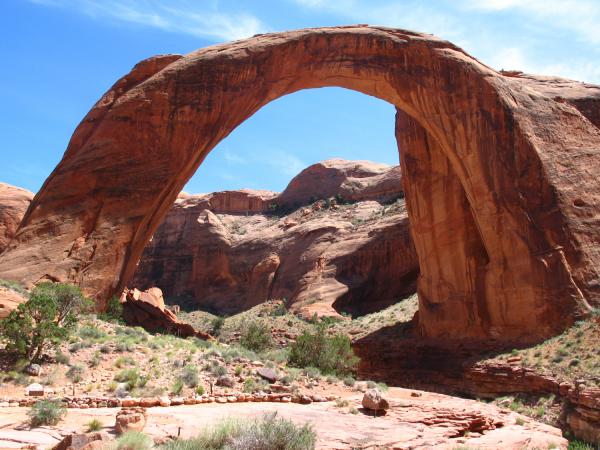
On the edge of Utah's Glen Canyon National Recreation Area is the world's largest known natural bridge. The bridge spans 234 feet (71 meters). At the top it is 42 feet (13 m) thick and 33 feet (10 m) wide.
Rainbow Bridge was created by rock formations that are hundreds of millions of years old, deposited in a time when the climate and terrain were very different from what they are today. As Bridge Creek flowed toward the growing Colorado River during the last ice age, it carved first through softer rocks and veered away from the harder Triassic and Jurassic sandstones, eventually creating a wide hairpin bend that flowed around a solid "fin" of sandstone that would become Rainbow Bridge.
The previous course of the creek is still visible above the bridge. Water flows back on itself at bends and wide spots, creating swirling eddies along the banks. As the creek flowed around the Rainbow Bridge fin, these abrasive eddies formed on both the upstream and downstream sides and cut circular alcoves in the rock wall. The sediment in the creek eventually scoured the softer layers of sandstone away, leaving the harder layers behind.
Glaciers - Glacier National Park, Montana
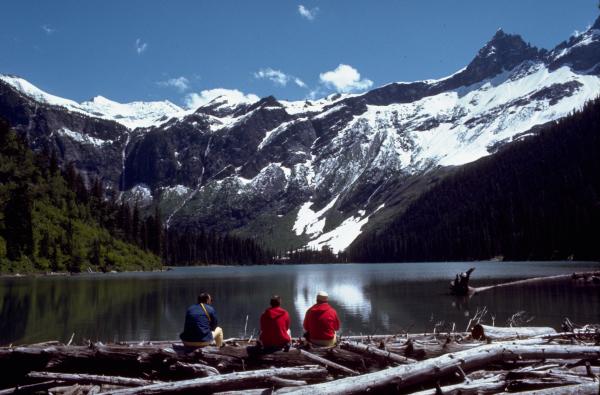
Glacier National Park is one of the best examples of glacier-carved terrain from a time 10,000 years in the past. But the park is more than just a nod to the past in fact, it has glaciers today and many can be seen from the roads around the park.
Their blue ice and crevasses separate them from the snowfield above the timberline. The alpine glaciers melt and re-freeze to move snow downhill like a conveyor belt. This cycle creates U-shaped valleys that are impressively vertical.
Redwood Trees - Redwood National Park, California
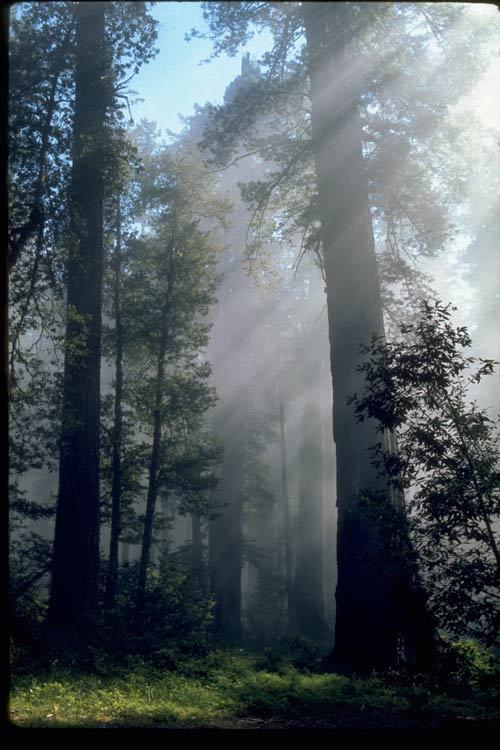
The California redwood (Sequoia sempervirens) and Douglas-fir (Pseudotsuga menziesii) are the two dominant trees of California's famous old-growth redwood forest.
The protected valleys and alluvial flats found along streams and creeks provide ideal growing conditions for the coast redwood, with many trees exceeding 300 feet (100 m) in height.
Hardy Sitka spruce (Picea sitchensis), able to withstand salt winds and harsh conditions better than other conifers, dominate the most exposed forest sites.
Sign up for the Live Science daily newsletter now
Get the world’s most fascinating discoveries delivered straight to your inbox.











